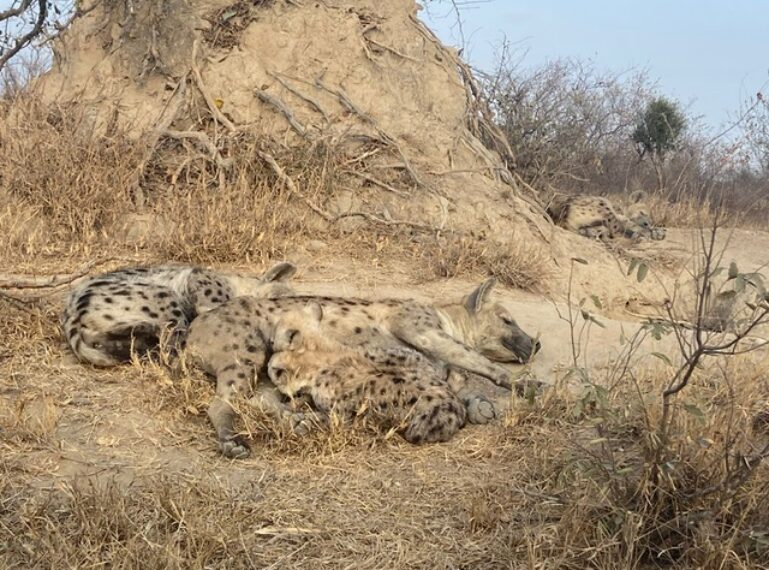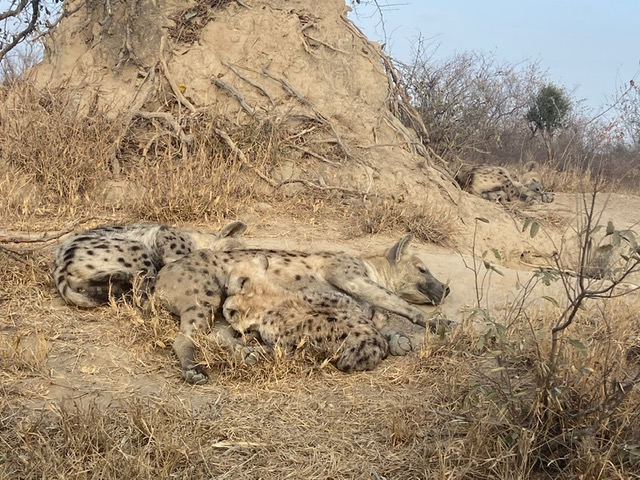
Hated by the playwright Hemingway and consistently depicted as the Disney villain, hyenas have a bad reputation for being nothing more than cackling bone-crushing scavengers. Given that they’re a vital part of the ecosystem of the wild, they certainly don’t deserve their rep. We love and respect hyenas, which is why we’re overjoyed to hear about the hyena den at Africa on Foot and nThambo Tree Camp in the Klaserie Private Nature Reserve.
They’ll be in the den site for at least 14 months before they’re weaned off and trained to hold their own in the wild. If you have a safari booked in the next few months, you’ll probably see the growing hyena cubs. The experience will be more meaningful if you’re armed with facts and knowledge about how the clans operate.
Complete with canines in tact and an eagerness to fight for dominance, hyena cubs are “born ready”. The jet-black cubs look a bit like jet-black Staffordshire bull terrier puppies and have soft, fluffy hair that becomes coarse as they mature and are able to hunt/scavenge for themselves. Nature works in amazing ways when it comes to an animal’s development—hair naturally becomes coarser so that it’s not matted while feasting on crimson carcasses and debris from kills.
Despite their readiness for the wild, cubs will remain in the den area for quite sometime. You can expect to see anything from one to three cubs playing outside the den area, practicing their dominance skills. The older females are generally spotted outside of the den area, on guard and ready to ward of predators.
Our Klaserie team have spent many drives observing these fierce, social and intelligent creatures raising their young, and now it’s time for you to view the hyena cubs of the Klaserie. But firsts, here are some facts.
Hyenas are an efficient clean-up crew
With their bone-crushing jaws and robust digestive system, hyenas can eat just about anything. Out of all the carnivorous mammals, hyenas have the strongest bite and deliver a whopping 1000 pounds of force behind a bite. When big cats or wild dogs are done with their feast, they leave behind an incredible mess of blood, guts and bones. This can rot and spread disease. With that powerful jaw of theirs, hyenas will swoop in and crunch the bones in one sitting. Not only does this remove debris from the kill site, but when the hyena produces scat, it’s rich in calcium. Hyena scat becomes an important source of calcium for leopard tortoises. Isn’t nature the greatest ecosystem? Because a hyenas have such strong stomach acids, it means they can also digest horns, hooves, ligaments and survive exposure to anthrax.
They live in a Matriarchal society
That’s right, clans are led by woman! Hyenas live in clans of up to 80 individuals, dominated by one female called the matriarch. Much like the Royal Family, the matriarch passes down her powerful genes to her cubs who go on to become leaders – she passes down the title. Her offspring and other females with their young fall under the ruling of the “queen”. Adult males are always the last in the pecking order, reduced to submissive outsider roles where they are forced to beg for inclusion, food and even sex. At the “food table”, males always eat last. Females have even evolved to be larger than their male counterparts, and do most of the hunting. They’re the epitome of female strength in the animal kingdom.
Exceptional hunters and scavengers
Hyenas are resourceful, displaying a high level proficiency when it comes to both hunting and scavenging. They’re basically all round successful carnivores. To maintain such a level of skill in such an unforgiving environment, a high level of bravado, aggression and industriousness is needed. A falsely held belief is that hyenas are purely scavengers. Hyenas are opportunistic, and if they can get hold of a “free” meal, then they’ll take it. Most of their gourmet meals come from lions. They scavenge because they can, and they’re good at it.
However, hyenas are incredibly successful hunters and actually kill up to 90% of their own meals. They hunt via a method called “coarsing” which is similar to that of the African wild dog. They have stamina and will chase prey until the point of exhaustion. They will stop at nothing to feed themselves and the other clan members.
A range of vocalisations
Hyenas have a total of 14 different vocalisations. Each vocalisation represents and emotion, with the most commonly heard being the chortles and giggles. The unmistakable whooping sound is heard well into the night, and is used to contact clan members. The hyper and excitable “laughing” is often heard around a kill site, and indicates anxiety and anticipation.

Leave a Comment